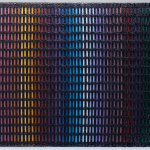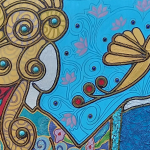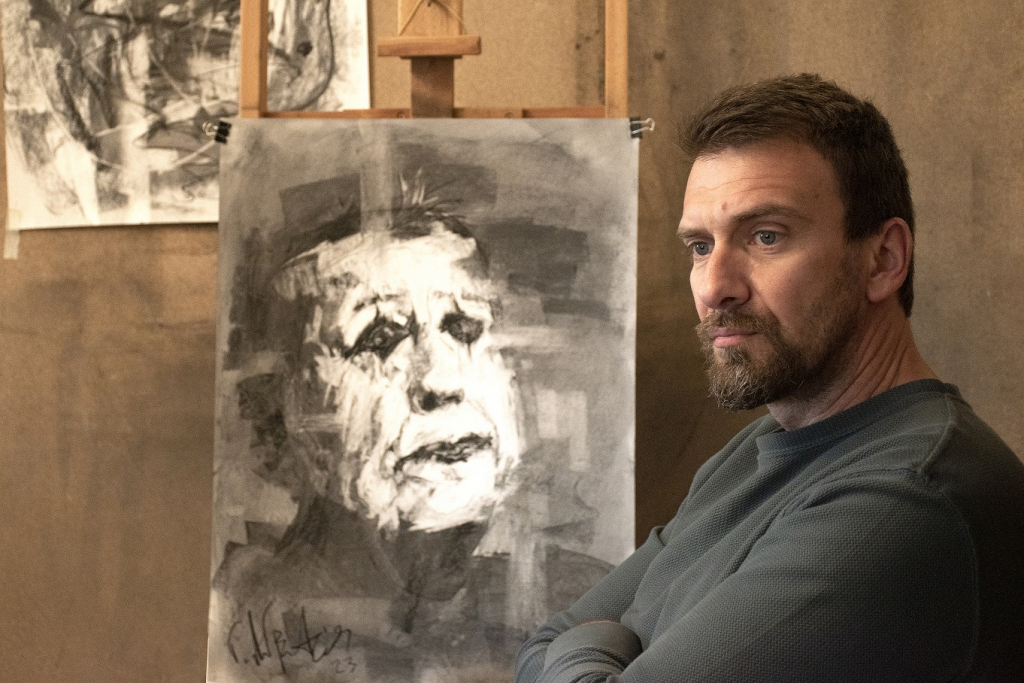
Malgrado un iniziale percorso di studi tecnici e matematici, nel successivo cammino si avvicina gradualmente a materie più umanistiche, in particolar modo alla filosofia, che poco dopo lo conducono verso l’arte perché il contatto con la propria interiorità, la pratica del dubbio come stimolo a rigenerarsi per trovare finalmente la sua vera strada, gli hanno permesso di osservare la realtà circostante e le persone che vi entrano a far parte, con un approccio di ricerca, di curiosità nei confronti di ciò che è, perché viene mostrato, e ciò che può essere tra le righe del visibile. Con una formazione tanto umanista l’artista greco George Androutsos non poteva che concentrarsi sui volti, sulle espressioni rubate in momenti di distrazione dei suoi protagonisti, su tutto quanto non viene mostrato nella quotidianità; ecco perché avverte l’esigenza, subito dopo aver eseguito i ritratti, di cancellare letteralmente alcune parti, allo stesso modo in cui un giovane Gerard Richter aveva fatto dopo essersi liberato dalle regole estetiche ed esecutive imposte dal regime della Germania dell’Est, e tanto quanto, seppure con stile e motivazione di partenza completamente differenti, ha contraddistinto la produzione di Francis Bacon. In ognuno di questi artisti, così come per George Androutsos, l’attenzione si focalizzava sull’individuo, sulle sue emozioni più segrete, sull’impossibilità o l’incapacità di rivelarle costringendolo così a rinunciare a una parte di sé, quella cancellata, quella deformata che però continuava e continua a vivere nell’essenza più profonda. Il mezzo espressivo di Androutsos è il carboncino e la base di partenza delle sue opere è realista, dunque affine all’aspetto esterno che viene colto dall’occhio, poi però l’azione successiva lo conduce a sfumare i dettagli, a passarvi e ripassarvi sopra con le linee della matita quasi mettendo l’osservatore davanti a una lente sfumata e confusa dietro la quale si ha bisogno di strizzare gli occhi per cercare di mettere a fuoco. Ed è esattamente in quel passaggio che avviene la ricerca della sostanza, perché quando non è possibile vedere con nitidezza allora entra in gioco l’interiorità, l’intuito che guida una riflessione differente, più profonda, maggiormente introspettiva; è questo ciò che manca nella società moderna, sembra suggerire l’artista, quella capacità di andare oltre la patina superficiale per ascoltarsi e comprendersi a un livello diverso spesso apparentemente irraggiungibile eppure più vero. Le parti cancellate diventano dunque un pretesto di approfondimento filosofico, un invito da parte di Androutsos a sollevare quel velo di estetica che contraddistingue il vivere di oggi e di spingersi verso un ascolto più sensibile nei confronti di chi non sa trovare la voce per narrare ciò che nasconde dietro la maschera che indossa. Il lavoro Aris
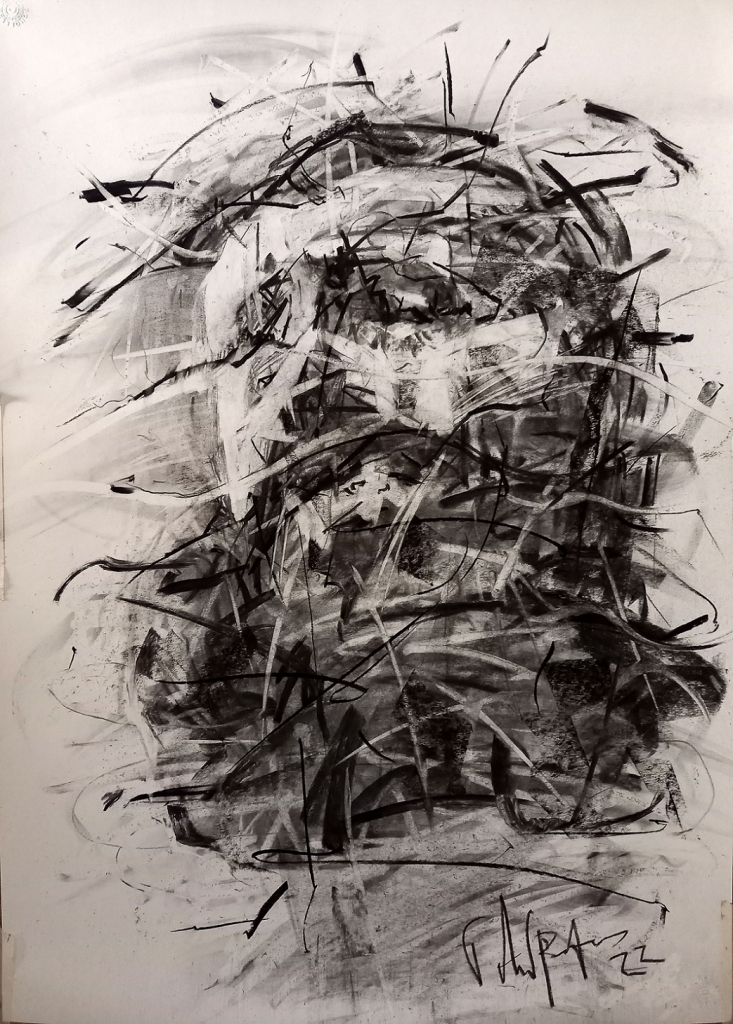
è particolarmente rappresentativo di questa spinta dell’artista, poiché il volto dell’uomo ritratto è quasi completamente irriconoscibile, cancellato da linee grafiche che ne confondono i tratti, permettendo solo alle sensazioni personali dell’osservatore di emergere; infatti tutto viene lasciato all’interpretazione soggettiva, perché sulla base dello stato d’animo o della personalità del fruitore si può immaginare un’espressione sorridente, o arrogante, o spaventata o infine sgomenta. Ed è questa la vera ricerca filosofica delle opere di George Androutsos, quella capacità di sollecitare un interesse maggiore rispetto alle nuove regole della società attuale più orientata a soffermarsi su un’estetica che dimentica non solo la sostanza bensì persino l’umanità. In Hernest Hamingway
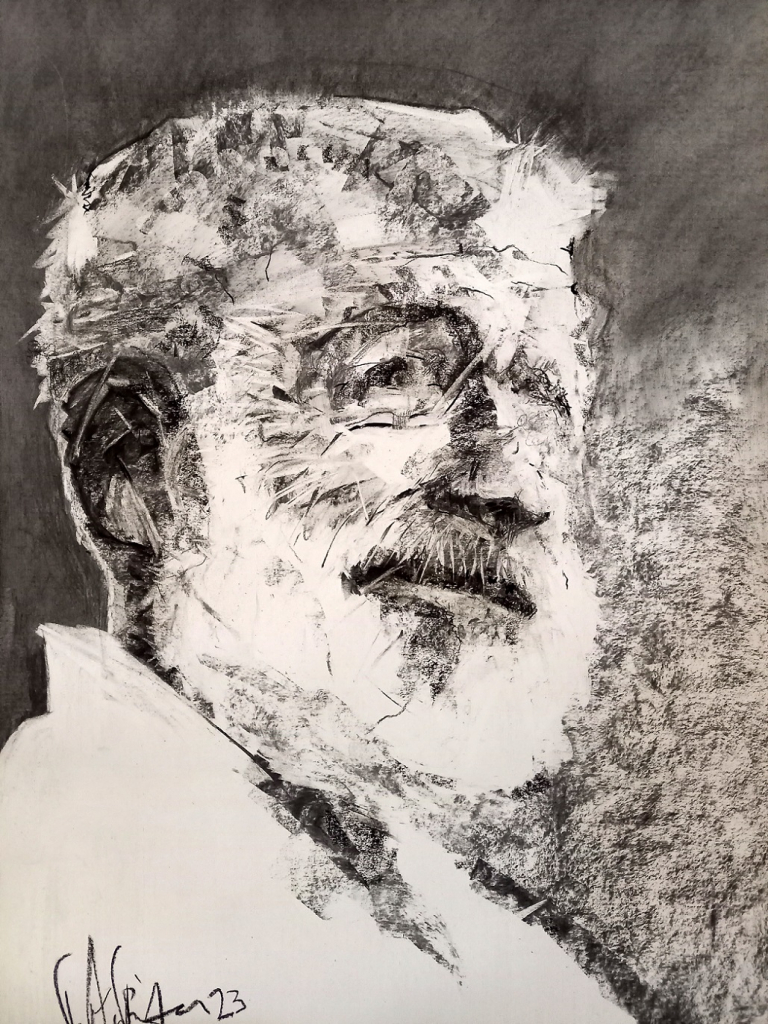
al contrario, il volto del gigante della letteratura statunitense è più riconoscibile, i suoi tratti sono evidentemente sereni, distesi, sorridenti, forse proprio perché nella sua epoca i rapporti interpersonali erano diversi, ancora orientati al dialogo, alla gentilezza, al senso di civiltà che oggi sembra perdersi dentro gli obiettivi personali anche a costo di prevaricare l’altro. Ciò che emerge dall’opera di George Androutsos è la purezza di fondo del grande romanziere, che si sprigiona malgrado la depressione che gli ha causato una dipendenza dall’alcool, più forse per incapacità di gestire la sua notorietà e la sua vita fuori dagli schemi che non per senso di isolamento da cui invece è affetto l’uomo contemporaneo. Andiamo ora ad approfondire la conoscenza con l’artista.
George, lei ha alle spalle un corso di studi particolare e anche variegato che l’ha portata a confrontarsi con materie apparentemente opposte e dunque con approcci differenti alla realtà. Quanto gli studi hanno influenzato il suo stile davvero particolare e riconoscibile? Quanto è stata importante la filosofia per determinare la sua scelta artistica e per tracciare il cammino di ricerca interiore che contraddistingue i suoi lavori?
Qualsiasi studio aiuta a costruire la propria personalità e questo vale per chiunque. Io sono quello che sono grazie ai miei studi e alle mie esperienze. Disegno in questo modo grazie ai fatti che hanno composto la mia linea di vita. La filosofia come pratica quotidiana mi aiuta a pensare al di fuori di me stesso, ai valori di questo mondo, alla verità se esiste, allo scopo dell’uomo, alla bellezza, alle cause ultime. Credo che tutto questo sia concentrato nel gesto del disegno, dove è costantemente presente anche il senso di agonia nei confronti del mondo.

Perché ha deciso di esprimersi attraverso il carboncino? Crede vi sia un’affinità tra la sua esigenza di cancellare i volti che descrive e la malleabilità del tratto grafico? Oppure c’è un’altra ragione alla base della sua scelta?
Sì, c’è una relazione complementare tra il gesto della cancellazione e la malleabilità della linea grafica. Ma in realtà amo il carboncino perché è la prima e basilare unità strutturale che esprime concetti e idee. Il disegno è la prima poesia incompiuta, la prima schermaglia interna al processo creativo. I disegni a carboncino possono esprimere la verità più pura e indicibile per ogni persona. La visione di questa verità interiore non dura a lungo, è oscurata dalla realtà, riesco appena a catturarla frettolosamente ma non semplicemente sul foglio bianco.
Lei è anche insegnante di disegno alla scuola d’arte; il George Androutsos insegnante riesce a far tacere l’artista oppure inevitabilmente nelle sue lezioni lascia emergere anche l’approccio filosofico che la contraddistingue? Intendo dire, quanto è difficile dover dare delle linee guida tradizionali quando il suo stile è così personale e indefinibile?
Penso che non sia mai facile insegnare qualcosa come l’arte, ma è divertente e offre molto nello sviluppo a tutto tondo della personalità di una persona. Tuttavia, con il tempo l’insegnamento diventa un’abitudine ricca di risorse, si può imparare a insegnare.
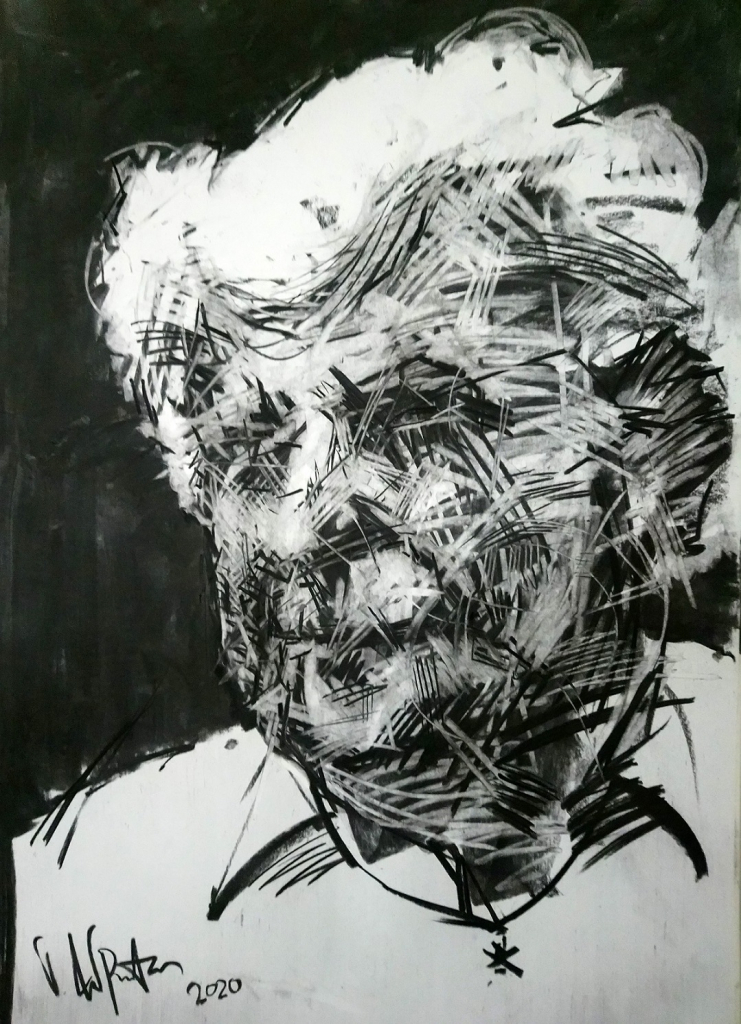
Nel testo introduttivo ho citato Bacon e Richter da giovane ma quali sono i maestri del passato a cui si ispira? Quali quelli da cui ha attinto la sua attitudine introspettiva e al tempo stesso empatica nei confronti degli individui che sceglie di ritrarre?
Non mi ispiro troppo al passato, lo rispetto e lo ammiro. Ma mi piace vedere nuovi pittori in tutto il mondo, provenienti da qualsiasi luogo e cultura. Mi piacciono gli artisti vivi e creativi provenienti da Corea, Russia, Europa, America e molti altri Paesi. Ci sono così tanti grandi artisti viventi che mi viene da chiedermi perché questo mondo è così brutto anche se possiamo produrre così tanta bellezza? Probabilmente l’arte non può salvare il mondo, ma potrebbe renderlo un po’ più sopportabile.

Lei ha avuto molte soddisfazioni dalla sua carriera artistica, ha vinto numerosi premi, ha partecipato a manifestazioni internazionali, ha al suo attivo diverse mostre personali in Francia e in Grecia. Quali sono stati gli eventi che le hanno dato maggiore emozione? E quali sono i suoi prossimi progetti?
Non credo tanto nella carriera quanto nel duro lavoro, nel lavoro su noi stessi, con la nostra comunità e con tutto l’amore che abbiamo. Ma sono molto felice per quello che ho fatto finora e sono concentrato su quello che devo fare dopo. Sono orgoglioso di ciò che ho realizzato da solo, ma ho ancora molta strada da fare. La ricerca e la sperimentazione visiva non finiscono mai, imparo dai miei errori e vado avanti. Credo che le mostre personali a Parigi e a Nizza, in Costa Azzurra, e tutte le partecipazioni alle biennali siano stati gli eventi più importanti per me. Il prossimo progetto è una mostra personale in Europa.
GEORGE ANDROUTSOS-CONTATTI
Email: gandrouart@gmail.com
Sito web: https://www.behance.net/gandrout
Facebook: https://www.facebook.com/george.androutsos.1
Linkedin: https://www.linkedin.com/in/george-androutsos-6940a197/
Pinterest: https://www.pinterest.it/gandrousm/
Marta Lock’s interviews: George Androutsos, faces erased in search of a new philosophy of art
Despite an initial course of technical and mathematical studies, in his subsequent journey he gradually approached more humanistic subjects, especially philosophy, which shortly afterwards led him towards art, because contact with his own interiority, the practice of doubt as a stimulus to regenerate himself in order to finally find his true path, allowed him to observe the surrounding reality and the people who are part of it, with an approach of research, of curiosity about what is, why it is shown, and what can be between the lines of the visible. With such a humanist background, the Greek artist George Androutsos could only concentrate on the faces, on the expressions stolen in moments of distraction of his protagonists, on everything that is not shown in everyday life; that is why he feels the need, immediately after having executed the portraits, to literally erase certain parts, in the same way that a young Gerard Richter did after having freed himself from the aesthetic and executive rules imposed by the East German regime, and as much as, albeit with a completely different style and starting motivation, characterised the production of Francis Bacon. In each of these artists, as well as for George Androutsos, the focus was on the individual, on his most secret emotions, on the impossibility or inability to reveal them, thus forcing him to renounce a part of himself, the erased part, the deformed part that nonetheless continued and continues to live in his deepest essence. Androutsos’ expressive medium is charcoal and the starting point of his artworks is realistic, therefore akin to the external appearance that is caught by the eye, but then the subsequent action leads him to blur the details, to go over and over them with the lines of the pencil as if putting the observer in front of a blurred and confused lens behind which one needs to squint to try to focus. And it is exactly in that passage that the search for substance takes place, because when it is not possible to see clearly then interiority comes into play, the intuition that guides a different, deeper, more introspective reflection; this is what is lacking in modern society, the artist seems to suggest, that ability to go beyond the superficial veneer to listen to oneself and understand oneself on a different level that is often apparently unattainable and yet truer. The erased parts thus become a pretext for philosophical investigation, an invitation on Androutsos’ part to lift that veil of aesthetics that characterises today living and to move towards a more sensitive listening to those who cannot find the voice to narrate what they hide behind the mask they wear. The work Aris is particularly representative of this drive of the artist’s, since the face of the man portrayed is almost completely unrecognisable, erased by graphic lines that blur his features, allowing only the personal feelings of the observer to emerge; in fact, everything is left to subjective interpretation, because on the basis of the mood or personality of the viewer one can imagine a smiling, or arrogant, or frightened or finally dismayed expression. And this is the true philosophical quest of George Androutsos’ artworks, that ability to solicit a greater interest than the new rules of today’s society, more oriented towards an aesthetic that forgets not only substance but even humanity. In Hernest Hamingway, on the contrary, the face of the giant of American literature is more recognisable, his features are evidently serene, relaxed, smiling, perhaps precisely because in his era interpersonal relations were different, still oriented towards dialogue, kindness, and a sense of civilisation that today seems to get lost in personal objectives even at the cost of prevaricating the other. What emerges from the work of George Androutsos is the underlying purity of the great novelist, which is unleashed despite the depression that caused him to become addicted to alcohol, more perhaps due to an inability to manage his notoriety and his life outside the box than to a sense of isolation from which contemporary man is afflicted. Let us now get to know the artist better.
George, you have behind you a particular and also varied course of studies that has led you to deal with apparently opposing subjects and therefore different approaches to reality. How much have your studies influenced your very particular and recognisable style? How important was philosophy in determining your artistic choice and in tracing the path of inner research that characterises your work?
Any study have anyone made, it help to construct his personality. I am who I am because of my studies and my experience. I draw this way because of this facts, which have composed my life line. Philosophy as daily practice helps me think out of my self, the values of this world, the truth if there is any, the purpose of human, the beauty, ultimate causes. I believe that all of this is concentrated in the gesture of the drawing. The agony about the world is present.
Why did you decide to express yourself through charcoal? Do you think there is an affinity between your need to erase the faces you describe and the malleability of the graphic line? Or is there another reason behind your choice?
Yes there is a complementary relation between the erase gesture and the malleability of the graphic line. But truly I love charcoal because is the first and basic structural unit that expresses concepts and ideas. Drawing is the first unfinished poem, the first internal skirmish inside the creative process. Charcoal drawings can express the purest untold truth for each person. The view of this inner truth does not last long, it is overshadowed by reality, I barely manage to capture it hastily but not simply on the white paper.
You are also a drawing teacher at the art school; does the George Androutsos teacher manage to silence the artist, or do you inevitably also allow your philosophical approach to emerge in your lessons? I mean, how difficult is it to give traditional guidelines when your style is so personal and indefinable?
I think is never easy to teach something like art, but it is entertaining and it offers a lot in the all-round development of a person’s personality. However, over time teaching becomes a resourceful habit, we can learn how to teach.
In the introductory text I mentioned Bacon and Richter when he was a young man, but which past masters do you get inspired from? Which ones have you drawn from for your introspective yet empathetic attitude towards the individuals you choose to portray?
I am not inspired too much from the past, I respect and I admire it. But I like to see new painters around the globe from any places and cultures. I like artists who are alive and creative from Korea, Russia, Europe, America and many other countries. There are so many great alive artists that make me wonder why this world is so bad although we can produce so much beauty? Probably art cannot save the world, but it might make it a little bit bearable.
You have had a lot of satisfaction from your artistic career, you have won numerous awards, participated in international events, and have several solo exhibitions in France and Greece to your credit. What events have given you the biggest emotion? And what are your next projects?
I do not believe in career so much as I trust the hard work, work with ourselves, with our community and work with whatever love we have. But I am very happy for what I have done until now and I’m focused on what I have to do next. I am proud for what have accomplished by myself but yet I have long way. The Visual research and experimentation never ends, I learn from my mistakes and move forward. I think the solo exhibition in Paris and Nice, cote d’azur and all the biennial participations was the greatest events for me. Next plan is a solo exhibition in Europe.

